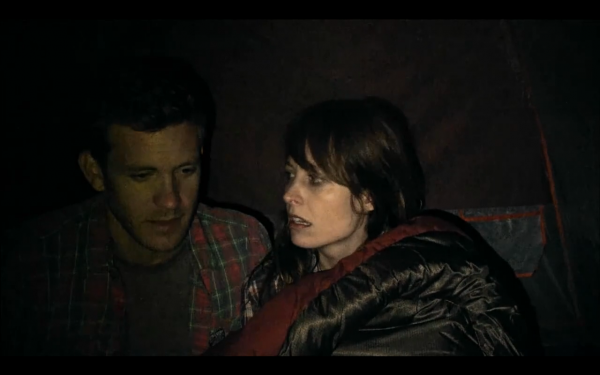15 years after the release of The Blair Witch Project, Bobcat Goldthwait (the very same) has directed his own “found footage” horror movie. That film, Willow Creek, is both a fitting tribute to a simpler time in the sub-genre’s (shortish) history, as well as an example of what filmmakers and audiences have come to demand of this brand of cinema in the last decade and a half. Because while The Blair Witch Project was able to create a witch out of bundled sticks and little else, Goldthwait knows that audiences need a bit more than that to believe in (or at least fear) Bigfoot.
The film centers around Jim (Bryce Johnson) and his girlfriend Kelly (Alexi Gilmore), who take a tour of the Pacific Northwest in an effort to capture some modern footage of Bigfoot in the same stretch of forrest where the famous Patterosn-Gimlin film was shot. It’s a smart move on Goldthwait’s part to so quickly (and often) remind the audience that, as The Slenderman is to reddit kids, so Bigfoot is to an era of people who associated grainy, 8mm footage with real-life terror like the Kennedy assassination. Bigfoot and “found footage” have a long history together, the former owing his (or her) nearly 50 years of infamy to some 16 seconds of film. But Goldthwait doesn’t allow the simple association to stand on its own; instead, he uses the first 40ish minutes to place his characters in real-life locations that trade on the legend to sell tourists Bigfoot-shaped burgers (which look fucking great, by the way). The rest of that time is spent with Jim interviewing local Bigfoot “experts” (one of whom hilariously does not believe in the creature), while Kelly, a good sport, films everything.
If this sounds familiar, it’s because it is. Most of the people “interviewed” in the film appear to be, much like The Blair Witch Project, “real” locals. Some of the acting is more obvious than the rest, but the time is still well spent, building the myths around the creature and giving the audience quality time with our two leads. Their banter is smartly rendered, setting Kelly up as the reluctant skeptic, along for the ride because she likes spending time with Jim. And while Jim’s motivations are less clear (spoiler in Invisotext: this may all be an elaborate set-up for a marriage proposal), his level of research is high enough so that you believe his excitement about the project (even as he rolls his eyes through an admittedly awful song about Patterson and Gimlin).
None of this matters, or course, if the third act doesn’t deliver, and luckily it does. After an unwelcome reception at the driving path leading to their camp site (another familiar trope that nevertheless adds to the third act), we get a few subtle beats before the main event: an uninterrupted, 20 minute sequence set almost entirely in a small pop tent. It’s the best kind of low budget filmmaking, relying on clever sound design and performance to build the terror, but the long take is the real masterstroke here. Its un-showiness avoids the level of distraction people so often complain about when the same technique is used in something like True Detective or Gravity. The camera is locked off with only a small lamp to light the frame, but the effect is perfect. At a certain point, Kelly wonders if they should turn the light off, another simple question that nevertheless lends the scene another element of tension.
I’m not going to spoil where or how everything ends, but there’s “a fate worse than death” element that I’ve been thinking about in the week since my first viewing, and I still haven’t been able to shake it. Like I mentioned in the beginning of the review, what we’re shown is more explicit than anything in The Blair Witch Project, but the effect is the same. For all of the caparisons drawn between the two films by myself and others, I don’t think of them as unfavorable. With 15 years of additional media training, audiences have seen just about everything this genre has to offer by now. To that end, Goldthwait gives us something approaching the catharsis some felt lacking in TBWP, but his most lasting moment of terror comes from the implication of that image, rather than the image itself. That places Willow Creek in the realm of HP Lovecraft’s cosmic terror far more than the of-the-moment jump scares that populate most horror today. But it does that well too.



